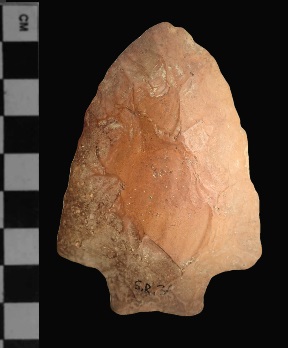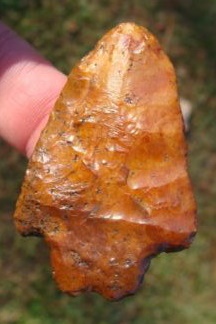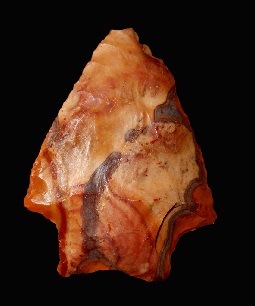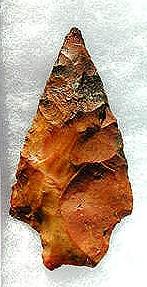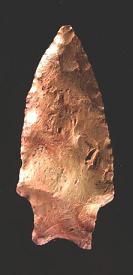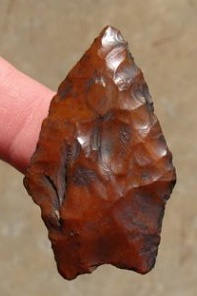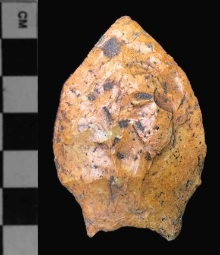Outline is Representative of Size and Shape:

Name Details:
Identified By: Ripley P. Bullen
Named For: Arredondo, Alachua County, Florida
Date Identified: 1968
Type Site:
Identified By: Ripley P. Bullen
Named For: Arredondo, Alachua County, Florida
Date Identified: 1968
Type Site:
Point Validity:
Valid type
Bullen was a distinguished Anthropologist and Curator Emeritus of the Florida Museum of Natural History. He was dedicated to identifying and typing projectile points from Florida. This point was named in a professional publication and is professionally a widely recognized type. This is a valid type.
Bullen was a distinguished Anthropologist and Curator Emeritus of the Florida Museum of Natural History. He was dedicated to identifying and typing projectile points from Florida. This point was named in a professional publication and is professionally a widely recognized type. This is a valid type.
Arredondo Stemmed
AKA: Arrendondo (misspelling)Cluster: Archaic Stemmed Cluster
Description of Physical Characteristics and Flaking Pattern:
This is a thick broad medium to large (1.75 to 4.75 inches) stemmed point with an elliptical cross section. The blade may vary from excurvate to straight. The shoulders are commonly weak and at an upward angle, but may vary to horizontal. The stem is wide and ranges from straight to slightly expanding. The base is short and may vary from concave to bifurcated. The tangs of the base are commonly rounded, but may range to sharp. This point has a random flaking pattern.
Size Measurements:
Total Length - 44 to 120 mm (average 55 to 65 mm), Stem Length - 11 to 20 mm, Blade Width - 35 to 55 mm (average 40 to 45 mm), Stem Width - 17 to 35 mm (average 25 mm on at shoulders and 22 mm at base) , Basal Concavity - 3 to 6 mm, Thickness - 9 to 15 mm, Basal Concavity - 4 to 7 mm
Total Length - 44 to 120 mm (average 55 to 65 mm), Stem Length - 11 to 20 mm, Blade Width - 35 to 55 mm (average 40 to 45 mm), Stem Width - 17 to 35 mm (average 25 mm on at shoulders and 22 mm at base) , Basal Concavity - 3 to 6 mm, Thickness - 9 to 15 mm, Basal Concavity - 4 to 7 mm
Commonly Utilized Material:
Coastal cherts and coral
Coastal cherts and coral
Additional Comments:
This point has not been reported in a site / level that has been radiocarbon dated. The exact age is still unknown. However, this point has been found at sites below ceramic levels and above Suwannee points giving an age between 10,000 to 4,000 B.P. Farr (2006), places this point as Early Archaic based on the bifurcated base which is more common to the Early Archaic period. He also notes the stratigraphic co-occurrence in Florida archaeological contexts suggesting that these points are coevals. Granger and Granger (2013) places this point in the Middle to Late Archaic period based on the dates of similar points such as the Pinto, Hanna, Duncan, and McKean points. This point has been found with a loose association with Hamilton points which could place the temporal placement between the Early to Middle Archaic Period. Bullen noted similarities of this point and the Pedernales point of Texas and assigned labeled it as a Late Archaic period point. Whatley (2002) notes the discrepancies of dating, but agrees with Bullen that this is most likely a Late Archaic period point. However, Whatley notes that if this were a Middle Archaic period point, it would solve the problem of of the missing Archaic point of the Georgia Coastal Plains.
Bullen (1975) distinguished Hamilton points from Arredondo points, noting that the Arredondo points have a weaker shoulder, a deeper basal concavity, and are generally thicker. Many other researchers feel that the difference between the two types rely solely on the depth of the basal concavity.
This point has not been reported in a site / level that has been radiocarbon dated. The exact age is still unknown. However, this point has been found at sites below ceramic levels and above Suwannee points giving an age between 10,000 to 4,000 B.P. Farr (2006), places this point as Early Archaic based on the bifurcated base which is more common to the Early Archaic period. He also notes the stratigraphic co-occurrence in Florida archaeological contexts suggesting that these points are coevals. Granger and Granger (2013) places this point in the Middle to Late Archaic period based on the dates of similar points such as the Pinto, Hanna, Duncan, and McKean points. This point has been found with a loose association with Hamilton points which could place the temporal placement between the Early to Middle Archaic Period. Bullen noted similarities of this point and the Pedernales point of Texas and assigned labeled it as a Late Archaic period point. Whatley (2002) notes the discrepancies of dating, but agrees with Bullen that this is most likely a Late Archaic period point. However, Whatley notes that if this were a Middle Archaic period point, it would solve the problem of of the missing Archaic point of the Georgia Coastal Plains.
Bullen (1975) distinguished Hamilton points from Arredondo points, noting that the Arredondo points have a weaker shoulder, a deeper basal concavity, and are generally thicker. Many other researchers feel that the difference between the two types rely solely on the depth of the basal concavity.
Distribution: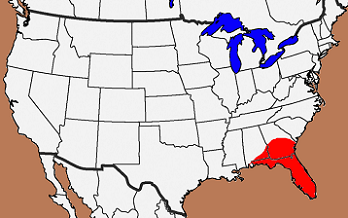

Distribution Comments:
This point is primarily found from south-central Florida into Southern Georgia and southeastern Alabama.
This point is primarily found from south-central Florida into Southern Georgia and southeastern Alabama.
Age / Periods:
Date: 7,500 - 5,000 B.P. (see comments)
Cultural Period: Middle Archaic
Glacial Period: Middle Holocene
Culture:
Date: 7,500 - 5,000 B.P. (see comments)
Cultural Period: Middle Archaic
Glacial Period: Middle Holocene
Culture:
Age Details:
See additional comments
See additional comments
Other points in this cluster / Related / Associated Points:
Alachua , Hamilton, Kirk Stemmed, Kirk Serrated, Levy, Marion, Putnam, Sumter, Thonotosassa
Alachua , Hamilton, Kirk Stemmed, Kirk Serrated, Levy, Marion, Putnam, Sumter, Thonotosassa

